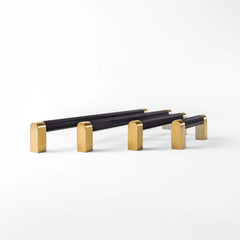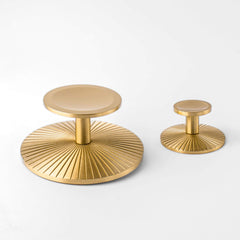Key Takeaways:
- How Unlacquered Brass Ages Gracefully: This finish gathers richness through touch, light, and time. Unlike lacquered or plated metals, unlacquered brass hardware develops a patina that reflects real life and deepens in tone and texture.
- Where Unlacquered Brass Belongs: From hardworking mudrooms to statement kitchens and curated living rooms, this finish brings warmth, weight, and quiet movement. Its presence bridges high-traffic function and elevated design without demanding perfection.
- How to Style Unlacquered Brass: When paired with dark, dramatic hues or soft, natural tones, unlacquered brass cabinet hardware adapts beautifully across aesthetics. Pair it with stone, wood, or color for depth and harmony.
In a world where trends flare and fade with the turning of a page, one truth endures: authenticity is always in style. Unlacquered brass hardware, the quietly luxurious, living finish found in remarkable homes, bespoke hotels, and design-forward kitchens, has reemerged as the material of choice for those who value presence over polish.
At Inspire Hardware, we’ve witnessed how the right cabinet pull or kitchen knob can spark a deep, almost alchemical sense of belonging. Our collections grew from a reverence for beautiful spaces and a desire to make that beauty more accessible. Let’s step into the world of unlacquered brass cabinet hardware and explore how this finish is shaping design trends and anchoring rooms in the kind of enduring elegance we crave.
How Unlacquered Brass Ages Gracefully
Unlike finishes that resist the passage of time, unlacquered brass hardware transforms with it. Compared to polished metals like sterling silver or plated chrome, unlacquered brass offers a more layered, sensory experience. Here's what sets it apart:
- Golden Tones That Deepen with Time: Sterling silver often tarnishes to a blue-gray tone that reads cool or even stark in softer interiors. Unlacquered brass develops into a sun-warmed palette of honey, copper, and deep bronze; perfect beside limestone, aged oak, or moody cabinetry with unlacquered brass kitchen hardware.
- A Patina That Reflects Its Surroundings: While plated hardware stays static and uniform, unlacquered brass responds to its environment. A drawer pull near a sunny window may wear differently than one on a lower cabinet, creating a natural contrast that adds depth to open-concept kitchens.
- Design That Grows with Every Gesture: Unlike finishes that demand perfection, unlacquered brass welcomes scratches, fingerprints, and subtle wear. That lived-in aesthetic adds harmony to rustic beams, honed stone, or the hand-glazed tiles often seen in bathrooms like those featured in bringing warmth to bathrooms with antique brass fixtures.
- Easy Maintenance: A soft cloth and gentle polish can restore brightness without erasing history. This blend of adaptability and permanence makes it a favorite among professionals looking to balance timeless elegance with real-life utility.
- Tactile Stories That Emerge Over Time: Unlike mirror-finish chrome, unlacquered brass cabinet hardware reflects the life happening around it. From a wine glass set down mid-recipe to a morning routine in motion, each mark becomes part of the room’s atmosphere.
Where Unlacquered Brass Belongs: Kitchens, Mudrooms, And Living Spaces That Glow
Unlacquered brass hardware brings a warmth and movement that can’t be replicated by sealed or plated finishes. Here’s how it transforms three essential spaces in your home.
Warmth And Depth In The Kitchen
In the kitchen, unlacquered brass becomes a sensory counterbalance to sleek appliances and sharp-edged surfaces. The finish begins bright but softens as each cabinet pull and drawer handle collects fingerprints and natural oils. Over time, the brass deepens into antique tones that settle beautifully against painted millwork, veined stone, or butcher block countertops.
This tactile evolution pairs especially well with palettes like forest green, matte navy, or warm white. Those drawn to classic New England kitchens or Parisian bistro-style interiors often gravitate toward unlacquered brass kitchen hardware for its understated elegance. For a refined touch, pair with our sculptural twist solid brass cabinet pulls, which balance structure with softness.
Mudrooms With Soul
Mudrooms see it all: rainy boots, backpacks, keys, and clutter. Even in this utilitarian setting, unlacquered brass cabinet hardware invites a welcoming aura to even the most high-traffic spaces. The finish quietly absorbs touch and moisture without feeling precious, maturing into a rich golden hue that holds its own beside soapstone sinks, slate flooring, or tongue-and-groove paneling.
Designers often reach for unlacquered brass hooks, rods, and bin pulls to elevate the rhythm of storage without overwhelming the space. In farmhouse-style homes or transitional builds, the hardware becomes a thread of visual consistency from one room to the next, softening high-traffic corners with its lived-in patina.
Living Rooms with A Lived-In Glow
In living spaces, unlacquered brass catches the afternoon light and brings organic contrast to curated surroundings. On built-in shelving, media cabinetry, or sideboards, the material adds subtle dimension without dominating the design. Earthy finishes like walnut, white oak, or matte paint tones bring out the brass’s warmth, making it feel rooted and intentional.
The evolving tone of unlacquered brass works beautifully in California casual, Scandinavian-inspired, or eclectic vintage interiors. For living rooms that lean into layered texture and tonal harmony, consider pairing the finish with natural textiles, aged leathers, and sculptural accents.
How To Style Unlacquered Brass With The Right Colors, Textures, And Materials
The beauty of unlacquered brass hardware lies in how it absorbs and reflects its surroundings. As the patina evolves, it draws out nuance from the textures and tones around it. These three palette families work beautifully in kitchens, bedrooms, bathrooms, and living spaces, each one shaping a distinct mood through material pairing.
Moody Blues, Deep Greens, And Soft Black
Saturated colors bring out the rich depth in unlacquered brass kitchen hardware. For example, charcoal, navy, and olive green offer contrast that lets the metal glow, rather than compete. In modern kitchens or traditional studies, this pairing feels grounded and architectural.
Pair these hues with matte black fixtures, hand-thrown ceramic tiles, or soapstone countertops. Walnut shelving or smoked oak cabinetry brings an extra layer of warmth. On built-ins or media walls, unlacquered brass pulls can visually bridge painted surfaces and natural wood grain.
Warm Neutrals And Soft Earth Tones
Ivory, taupe, sand, and bone tones coax out the golden hues in unlacquered brass cabinet hardware. In bedrooms, these palettes create a tranquil backdrop for unlacquered brass to quietly shine on dresser knobs or closet handles. In bathrooms, they soften the harder lines of tile and stone, adding a lived-in warmth.
Furthermore, natural textures, like travertine, rattan, boucle, or lightly oiled oak, add tactile interest without overwhelming the palette. On cabinetry, try pairing brass with our demi-lune hammered half-moon cabinet pulls for sculptural contrast that still feels restrained.
Classic White, Veined Stone, And Honeyed Wood
For those drawn to timeless interiors, pairing unlacquered brass with crisp white paint, honed marble, or blonde wood delivers an understated, high-end look. The finish feels clean but never sterile, rooted in tradition yet softened by wear.
This palette works across room types, from white kitchens with veined quartzite to airy guest rooms with ash-toned dressers and brushed linen upholstery. The hardware ages gracefully in these settings, picking up subtle color cues from nearby materials. For deeper design inspiration, explore hardware trends that blend minimalist tones with heritage-inspired texture.
Installation Tips For A Seamless Unlacquered Brass Upgrade
Swapping in unlacquered brass hardware is more than a quick cabinet refresh. Every knob and pull carries intention, tying together finish and function in spaces where detail matters. Whether you're updating a kitchen’s personality or adding quiet polish to a bathroom vanity, each step sets the stage for customized hardware.
Measure Twice, Mark Once
Precision is foundational. Before unscrewing a single fixture, map out the placement with a tape measure and soft pencil. For cabinetry with pre-existing holes, ensure your selected unlacquered brass hardware matches the hole spread exactly. Starting fresh? Use a template to maintain alignment—small missteps can disrupt the symmetry of clean-lined designs.
Prepare The Canvas
Wipe down all surfaces, doors, drawers, and panels with a gentle, residue-free cleaner. Dust and oils can interfere with a snug fit or mar the pristine finish of the brass. In historic homes, especially, look for subtle warping or paint buildup that could hinder flush installation.
Hand Tools Over Power Drill
To protect the finish, reach for a manual screwdriver instead of a power drill. This gives you better control, reduces the risk of overtightening, and prevents damage to surrounding surfaces. Steady pressure is enough to secure the hardware while preserving the integrity of each piece.
Protect The Patina’s Origins
During installation, use gloves or a soft cloth to prevent early fingerprints. Every touch begins the patina process, so if you're aiming to maintain the initial glow for a bit longer, minimize direct handling until each piece is secured.
Level Like You Mean It
Before final tightening, use a level to double-check alignment. Especially with longer pulls or handles, even a fraction of an inch can throw off the rhythm of your cabinetry’s profile. Step back, let natural light reveal any misalignment, and adjust as needed.
Savor The Transformation
What begins as a simple update often becomes a sensory upgrade. Unlacquered brass hardware catches light, absorbs the gestures of daily use, and refines your space with every passing touch. Take a moment to admire the subtle glow and allow the finish to settle in.
Final Thoughts
In a design that values texture, time, and storytelling, few details offer as much depth as unlacquered brass hardware. Its living finish begins with a soft satin glow and gradually deepens through touch, routine, and light. From unlacquered brass kitchen hardware that ages beside veined marble and painted cabinetry, to bedroom pulls that gather patina through morning routines, unlacquered brass transforms practical fixtures into sensory design elements.
At Inspire Hardware, we see hardware as an invitation to slow down and savor the details. Our unlacquered brass cabinet hardware is designed for those who care how a space feels just as much as how it looks. These are pieces that ground a space, gather memory, and grow more beautiful with time. Let your rooms tell their stories through us today.
Read more:
- A Step-by-Step Guide to Painting Kitchen Cabinets Like a Pro
- The Different Types Of Cabinet Hinges And How They Work
- Modern Kitchen Ideas: 10 Cabinet Designs for a Fresh Look
Frequently Asked Questions About Unlacquered Brass Hardware
Why is unlacquered brass trending in interior design?
Unlacquered brass and solid brass hardware are captivating designers and homeowners because they feel authentic, tactile, and alive. This finish forgoes the synthetic shine of lacquer to embrace a living surface that grows richer with time. At Inspire Hardware, we see unlacquered brass as our answer to the hunger for spaces that tell stories, rather than imitate them.
Why do homeowners prefer the natural aging of brass?
Few things spark joy quite like the patina of brass that’s been touched, polished, and loved through the years. Homeowners are gravitating to the organic transformation that unlacquered brass undergoes, watching as the hardware evolves from golden to softly muted, marked by the life lived around it.
What historical eras are associated with unlacquered brass?
Unlacquered brass rose to prominence in the 19th century, found in Victorian homes, Parisian cafes, and pre-war apartments. Its finish appears in Art Deco design as well, and continues through mid-century and modern revival aesthetics. Today’s designers use it to create a sense of visual continuity across eras.
Will water or fingerprints damage unlacquered brass?
Our unlacquered brass is made to live with you, not above you. Water droplets and the natural oils from your hands won’t damage the metal; instead, they’ll invite the patina to bloom. For those who savor the journey, every smudge tells a richer story. If you ever want to return to a brighter look, a gentle polish will restore some golden glow.
Can unlacquered brass fit with both traditional and contemporary styles?
Yes, this is where unlacquered brass shines! The finish carries weight in classic kitchens with paneled cabinets and marble counters, but also blends seamlessly with minimalist rooms that use clean lines and subtle textures. Unlacquered brass is design’s great chameleon: refined yet forgiving, bold yet subtle.
What are the drawbacks of choosing unlacquered brass hardware?
With beauty comes honesty: unlacquered brass requires emotional investment. If you crave perpetual perfection—untouched surfaces and pristine shine—this may not be your finish. Its surface will change. Patina and tarnish are inevitable, and for some, that natural unpredictability feels unruly, but for design lovers who value authenticity, unlacquered brass brings a kind of poetry—one that unfolds purposefully and slowly.
Does unlacquered brass require special care?
Maintenance is straightforward. Wipe each piece with a soft, dry cloth to lift dust and allow the patina to develop naturally. When a brighter tone is preferred, a touch of brass polish can restore glow without affecting the finish. Avoid harsh or abrasive cleaners to preserve its texture and depth.







